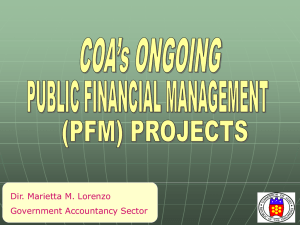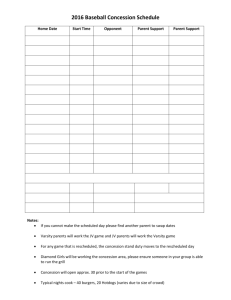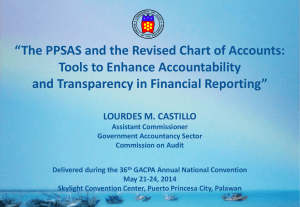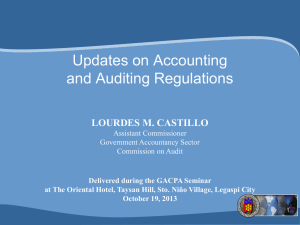The Revised Chart of Accounts and the Philippine Public Sector
advertisement
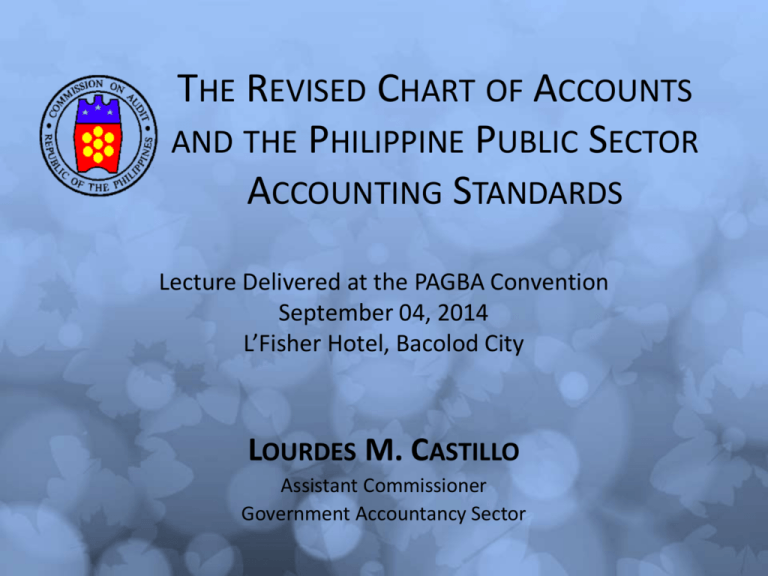
THE REVISED CHART OF ACCOUNTS AND THE PHILIPPINE PUBLIC SECTOR ACCOUNTING STANDARDS Lecture Delivered at the PAGBA Convention September 04, 2014 L’Fisher Hotel, Bacolod City LOURDES M. CASTILLO Assistant Commissioner Government Accountancy Sector Topical Outline 1. COA Circular No. 2013-002 dated January 30, 3013 “Adoption of the Revised Chart of Accounts for National Government Agencies” 2. COA Circular No. 2014-003 dated April 15, 2014 “Conversion from the Philippine Government Chart of Accounts under the New Government Accounting System per COA Circular No. 2004-008 dated September 20, 2004 as amended, to the Revised Chart of Accounts for National Government Agencies under COA Circular No. 2013-002 dated January 30, 2013, additional accounts/revised description/title of accounts and relevant Accounting Policies and Guidelines in the Implementation thereof” 3. COA Resolution No. 2014-003 dated January 24, 2014 “Adoption of the Philippine Public Sector Accounting Standards (PPSAS)” 4. Other Matters • Updates on eNGAS roll out at National Government Agencies (NGAs) and Local Government Units (LGUs) THE REVISED CHART OF ACCOUNTS COA Circular No. 2013-002 dtd. Jan. 30, 2013 Effectivity: January 1, 2014 Objectives To provide new accounts for the adoption of the Philippine Public Sector Accounting Standards (harmonized with IPSAS) To provide uniform accounts for national government accounting and budget systems to facilitate the preparation of harmonized financial and budgetary accountability reports To expand the account code from three (3) digits in the NGAS Chart of Accounts to eight (8) digits, to allow expansion or creation of new accounts as may be necessary to implement new standards or policies and provide up to four levels of consolidation depending on the users’ information needs. Major Changes a. Coverage is limited only to all national government agencies and GOCCs receiving funds constituted as Special Accounts in the General Fund (SAGF) from the National Government b. Expanded account code structure - from three (3) digits to eight (8) digits COA Revised Chart of Accounts ACCOUNT CODE STRUCTURE 0 00 00 00 0 Account Group Major Account Group Sub-Major Account Group General Ledger Accounts General Ledger Contra-Accounts ACCOUNT GROUPS Codes are assigned to account groups to facilitate location of accounts in the general and subsidiary ledgers, to provide systematic arrangement and classification of accounts and facilitate preparation of the consolidated financial reports as follows: Code 1 2 3 4 5 Account Groups Assets Liabilities Equity Income Expenses Asset without Contra Account Example: Cash-Collecting Officer 1 -01 -01 -010 Asset Cash and Cash Equivalents Cash on Hand Cash Collecting Officer GL Contra-Account Asset with Contra Account Example: Accounts Receivable 1 -03 -01 -010 Asset Receivables Loans & Receivable Accounts Accounts Receivable GL Contra-Account Asset with Contra Account Example: Allowance for Impairment - Accounts Receivable 1 -03 -01 -011 Asset Receivables Loans & Receivable Accounts Accounts Receivable Allowance for ImpairmentAccounts Receivable Major Changes New Accounts 1 02 01 010 1 02 02 011 Financial Assets Held for Trading Allowance for Impairment Investments in Treasury Bills Local in compliance with IPSAS 28-30 in compliance with IPSAS 29 (Financial Instruments Recognition and Measurement) 1 03 02 020 1 03 02 021 Finance Lease Receivable Allowance for Impairment Finance Lease Receivables Investment Property, Buildings Accumulated Depreciation Investment Property, Buildings Accumulated Impairment Losses Investment Property, Buildings in compliance with IPSAS 13 (Leases) in compliance with IPSAS 13 (Leases) 1 05 01 020 1 05 01 021 1 05 01 022 in compliance with IPSAS 16 (Investment Property) in compliance with IPSAS 16 (Investment Property) in compliance with IPSAS 26 (Impairment of Cash Generating Assets) New Accounts 10202010 Investments in Treasury Bills – Local 10202011 Allowance for Impairment - Investments in Treasury Bills - Local 10501010 Investment Property, Land 10501011 Allowance for Impairment - Investment Property, Land In compliance with IPSAS 29-30 In compliance with IPSAS 29-30 In compliance with IPSAS 16 In compliance with IPSAS 16 & 21 New Accounts 1 01 04 010 1 01 04 020 1 01 04 030 Cash-Treasury/Agency Deposit, Regular Cash - Treasury/Agency Deposit, Special Account Cash - Treasury/Agency Deposit, Trust Major Changes d. Some accounts were deleted since these accounts are for use by local government units or governmentowned and/or controlled corporations, while other accounts are no longer applicable to national government agencies. Deleted Accounts Example: 101 Cash in Vault for LGUs’ use 127 Real Property Tax for LGUs’ use Receivables 128 Special Education Tax for LGU’ use Receivables 144 Due from Other Funds not allowed 145 Due from Subsidiaries/ for GOCCs’ Affiliates use only Major Changes e. Some accounts were either expanded or compressed. For instance, expense accounts for repairs and maintenance and depreciation of property, plant and equipment which were previously presented per asset account were compressed based on the major account classification Compressed Accounts Example: 811 Repairs and Maintenance 5 02 13 040 Repairs and Office Buildings Maintenance812 Repairs and Maintenance Buildings and Other School Buildings Structure 813 Repairs and Maintenance Hospitals and Health Centers 814 Repairs and Maintenance Market and Slaughterhouses 815 Repairs and Maintenance Other Structures Compressed Accounts Example: 811 Depreciation-Office Buildings 812 Depreciation-School Buildings 813 Depreciation-Hospitals and Health Centers 814 Depreciation-Market and Slaughterhouses 815 Depreciation-Other Structures 5 05 01 040 Depreciation Buildings and Other Structures Repairs and Maintenance – Buildings and Other Structures • Subsidiary Ledgers: 01 - Buildings 02 - School Buildings 03 - Hospitals and Health Centers 04 - Markets 05 - Slaughterhouses 06 - Hostels and Dormitories 99 - Other Structures Depreciation - Buildings and Other Structures 5-05-01-040 • Subsidiary Ledgers: 01 - Buildings 02 - School Buildings 03 - Hospitals and Health Centers 04 - Markets 05 - Slaughterhouses 06 - Hostels and Dormitories 99 - Other Structures Expanded Account Example: 716 Subsistence, Laundry and Quarters Allowance 5 01 02 050 Subsistence Allowance 5 01 02 060 Laundry Allowance 5 01 02 070 Quarters Allowance Expanded Account Example: Cash - National Treasury, Modified Disbursement System (MDS) 1 01 04 040 Cash-Modified Disbursement System (MDS), Regular 1 01 04 050 Cash-Modified Disbursement System (MDS), Special Account 1 01 04 060 Cash-Modified Disbursement System (MDS), Trust 26 ADDITIONAL ACCOUNTS Created in 2014 New Accounts 1 01 04 000 Treasury/Agency Cash Accounts 1 01 04 070 Cash – Tax Remittance Advice 1 01 04 080 Cash – Constructive Income Remittance New Accounts Cash – Tax Remittance Advice (1-01-04-070) Remitting books • remittance thru TRA (debit) • constructive receipt of NCA (credit) BIR books • constructive receipt of remittance thru TRA (debit) • closing to Accumulated Surplus/(Deficit) (credit) New Accounts Cash – Tax Remittance Advice (1-01-04-070) BTR books • TRA issued (credit) • Closing to Accumulated Surplus/ (Deficit) (Credit) New Accounts 1 06 12 000 Service Concession Assets 1 06 12 010 Service Concession - Road Networks 1 06 12 011 Accumulated Depreciation - Service Concession - Road Networks 1 06 12 012 Accumulated Impairment Losses -Service Concession - Road Networks 1 06 12 020 Service Concession - Flood Control Systems 1 06 12 021 Accumulated Depreciation - Service Concession - Flood Control Systems 1 06 12 022 Accumulated Impairment Losses - Service Concession - Flood Control Systems 1 06 12 030 Service Concession - Sewer Systems 1 06 12 031 Accumulated Depreciation - Service Concession - Sewer Systems 1 06 12 032 Accumulated Impairment Losses - Service Concession - Sewer Systems New Accounts 1 06 12 040 Service Concession - Water Supply Systems 1 06 12 041 1 06 12 042 1 06 12 050 Accumulated Depreciation - Service Concession - Water Supply Systems Accumulated Impairment Losses - Service Concession - Water Supply Systems Service Concession - Power Supply Systems 1 06 12 051 1 06 12 052 1 06 12 060 1 06 12 061 1 06 12 062 Accumulated Depreciation - Service Concession - Power Supply Systems Accumulated Impairment Losses - Service Concession - Power Supply Systems Service Concession - Communication Networks Accumulated Depreciation - Service Concession - Communication Networks Accumulated Impairment Losses -Service Concession Communication Networks New Accounts 1 06 12 061 Accumulated Depreciation - Service Concession - Communication Networks 062 Accumulated Impairment Losses -Service Concession Communication Networks 070 Service Concession - Seaport Systems 1 06 12 071 Accumulated Depreciation - Service Concession - Seaport Systems 1 06 12 1 06 12 072 Accumulated Impairment Losses - Service Concession - Seaport Systems 080 Service Concession - Airport Systems 1 06 12 081 Accumulated Depreciation - Service Concession - Airport Systems 1 06 12 082 Accumulated Impairment Losses - Service Concession - Airport Systems 090 Service Concession - Parks, Plazas and Monuments 1 06 12 1 06 12 1 06 12 New Accounts 1 06 12 091 Accumulated Depreciation - Service Concession - Parks, Plazas and Monuments 1 06 12 092 Accumulated Impairment Losses - Service Concession - Parks, Plazas and Monuments 1 06 12 990 Other Service Concession Assets 1 06 12 991 Accumulated Depreciation - Other Service Concession Assets 1 06 12 992 Accumulated Impairment Losses - Other Service Concession Assets New Accounts Liability 2 01 01 090 Service Concession Arrangements Payable 2 05 01 020 Deferred Service Concession Revenue Revenue 4 02 02 240 Service Concession Revenue New Accounts Expenses 5 05 01 5 05 110 Depreciation – Service Concession Assets 04 090 Loss on Initial Recognition of Biological Assets Revised/Modified Accounts Expenses 3 01 010 0100 Government Equity 3 03 1 10 Income and Expense Summary Renamed as: 3 01 01 0100 Accumulated Surplus/(Deficit) 3 03 01 10 Revenue and Expense Summary CONVERSION OF THE NGAS CHART OF ACCOUNTS TO THE REVISED CHART OF ACCOUNTS (RCA) COA Circular No. 2014-003 dated April 15, 2014 Re: “Conversion from the PGCA to RCA” PURPOSE: Provide guidelines and procedures on the conversion of the PGCA to the RCA Provide accounting policies and guidelines on the implementation of the RCA for NGAs Provide additional and revised description/ title of accounts for proper implementation of the new and revised accounting policies COA Circular No. 2014-003 dated April 15, 2014 Re: “Conversion from the PGCA to RCA” COVERAGE: Shall be adopted for all funds of NGAs and for Special Accounts in the General Fund (SAGF) maintained by GOCCs For agencies implementing the eNGAS, procedures on the Conversion of the eNGAS databases to the RCA for NGAs shall be covered by separate guidelines The Chart of Accounts for GOCCs and LGUs and its conversion shall be covered by separate guidelines Basis for Conversion Balance Sheet as of December 31, 2013 Guide for Conversion of Accounts Matrix on the Conversion of Accounts of the PGCA to the RCA - Annex A 25 PPSAS General Guidelines and Procedures All NGAs and GOCCs with SAGF shall effect the conversion based on the Balance Sheet as of December 31, 2013 The Chief Accountants/Heads of Accounting units shall be guided by the Matrix on the Conversion of Accounts The Chief Accountants/Heads of Accounting units shall carefully analyze the GL and SL accounts before conversion Any clarification or request for assistance shall be directed to the Government Accountancy Sector (GAS), COA Specific Guidelines/Procedures Analyze balances as of December 31, 2013 Prepare JEVs to close the accounts and transfer to the appropriate account Furnish COA Auditor and GAS copies of the JEVs Specific Accounting Policies and Guidelines Maintenance of NG books shall be discontinued. A separate set of books shall be maintained by fund. All balances as of December 31, 2013 shall be transferred to the appropriate new books. • Bases shall be the law creating the fund • Copies of the JEV shall be furnished the COA Auditor and the COA-GAS separately Appropriate SLs shall be maintained for real accounts and for some income and expense accounts Specific Accounting Policies and Guidelines Public Infrastructures and Reforestation projects shall be recorded in the appropriate fund using PPE account • Based on acquisition cost showing the computed depreciation or appraised value whichever is determinable Specific Accounting Policies and Guidelines Revenue/Income shall be recognized by the revenue generating agency using the appropriate revenue/income accounts whether authorized to use or not For Revolving Funds, income and expenses shall be recognized, the net surplus of which shall form part of the equity of said fund Specific Guidelines/Procedures ITEMS IN TRANSIT (284) If the balance pertains to delivered items but not recorded, determine the reason for not recording the transaction and work for the gathering of the supporting documents to warrant the recording in the books of accounts. If the balance pertains to fixed assets that were converted to 284 upon implementation of the NGAS and which remain undelivered as of December 31, 2013, close the said account to Government Equity. New Accounts/Revised Title and Description of Account For PPSAS 32 – “Service Concession Arrangements – Grantor”, use the new accounts as prescribed in Annex B In conformity with PPSAS 1, the title of the following accounts shall be revised: • Account “Government Equity” (30101010) shall be • changed to “Accumulated Surplus/Deficit” (30101010). Account “Income and Expense Summary” (30301010) shall be changed to “Revenue and Expense Summary”(30101010). Sample Conversion Entry Petty Cash Fund Cash in Bank - Local Currency, Current Account Cash in Bank - Local Currency, Savings Account 1 01 01 020 97,300 1 01 02 020 1,303,000 1 01 02 030 1,412,000 Due from National Government Agencies 1 03 03 010 7,800,000 Office Supplies Inventory 1 04 04 010 1,000,000 Non-Accountable Forms Inventory 1 04 04 030 200,000 Petty Cash Fund Cash in Bank - Local Currency, Current Account Cash in Bank - Local Currency, Savings Account 104 97,300 111 1,303,000 112 1,412,000 Due from NGAs 136 7,800,000 Office Supplies Inventory 155 1,200,000 Sample Conversion Entry Prepaid Registration 1 99 02 030 672,000 Other Prepayments Office Equipment 1 99 02 990 1 06 05 020 5,000,000 2,480,000 Furniture and Fixtures Other Property, Plant and Equipment 1 06 07 010 2,615,000 Other Prepaid Expenses Office Equipment 1 06 99 990 1,637,000 185 221 5,672,000 2,480,000 Furniture and Fixtures 222 2,615,000 Other Property, Plant and Equipment 250 1,637,000 Sample Conversion Entry Accumulated Depreciation - Office Equipment Accumulated Depreciation – Furniture and Fixtures Accumulated Depreciation - Other Property, Plant and Equipment 321 1,840,000 322 2,615,000 350 1,117,300 Accumulated Depreciation - Office Equipment 1 06 05 021 1,840,000 Accumulated Depreciation Furniture and Fixtures 1 06 07 011 2,615,000 Accumulated Depreciation - Other Property, Plant and Equipment 1 06 99 991 1,117,300 Sample Conversion Entry Due to BIR 412 502,000 Due to GSIS 413 51,100 Due to PAG-IBIG Due to PHILHEALTH 414 13,000 415 14,000 Due to Other NGAs 416 606,000 Government Equity 501 17,457,900 Due to BIR 2 02 01 010 502,000 Due to GSIS 2 02 01 020 51,100 Due to PAG-IBIG 2 02 01 030 13,000 Due to PHILHEALTH 2 02 01 040 14,000 Due to NGAs 2 02 01 050 606,000 Government Equity 3 01 01 010 17,457,900 Transitory Provisions New account titles should be used in the implementation of the PPSAS Accounts that have not been converted due to issues not settled as of the conversion date shall be converted to the most appropriate account in the RCA until further defined Responsibility The Chief Accountants/Heads of Accounting units and Budget Officers/Heads of Budget Office/ units shall be responsible for the conversion of these accounts The Philippine Public Sector Accounting Standards (PPSAS) LEGAL BASES Article IX-D, 1987 Philippine Constitution “To promulgate auditing and accounting rules and regulations so as to facilitate the keeping, and enhance the information value of the accounts of government.” COA Resolution No. 2014-003 dated Jan. 24, 2014 “Adoption of the Philippine Public Sector Accounting Standards (PPSAS)” Creation of the Public Sector Accounting Standards Board (PSAcSB) COA Resolution No. 2008-012 dated Oct. 10, 2008 COA Office Order No. 2010-118 dated Feb. 19, 2010 COA Office Order No. 2013-622 dated Oct. 01, 2013 Functions of the PSAcSB Assist the COA Commission Proper in formulating and implementing accounting standards for the public sector. Establish and maintain linkages with international bodies, professional organizations and academe on accounting related fields on financial management. Bases of PPSAS Pronouncements issued by IPSASB (IPSASs), IASB, PICPA, International Organization of Supreme Audit Institutions and others. Relevant factors, including best accounting practices, and Capacity of Agencies to comply with PPSAS. Objective To set out the recognition, measurement, presentation and disclosure requirements for financial reporting in the Philippine Government. Scope PPSASs set out requirements dealing with transactions and other events in general purpose financial reports. PPSASs are designed to apply to the general purpose financial reports of all public sector entities other than Government Business Enterprises (GBEs) Applies to all NGAs, LGUs and GOCCs not classified as GBEs Methodology I. Evaluation of IPSAS Studied and evaluated each IPSAS to determine applicability II. Development of PPSAS Provided the PAG for IPSAS provisions which were not adopted Exposed drafts to stakeholders Addressed fundamental issues Conducted Focus Group Discussions III. Preparation/Update of Government Accounting Manual Studied, enhanced and modified the provision of Government Accounting Manual, as PPSASs are being developed. IV. Revision of the Chart of Accounts Revised the Chart of accounts to conform with the PPSAS and COA Circular 2013-002 dated Jan. 30, 2013. Contents PPSAS consists of International Public Sector Accounting Standards (IPSASs) (Accrual Based IPSASs per 2012 Handbook) developed by IPSASB and published by the International Federation of Accountants (IFAC), and Philippine Application Guidance (PAG) Philippine Application Guidance (PAG) Provide supplementary guidance of IPSASs to suit the Philippine public sector situation. States the reason for not adopting some paragraphs of the IPSASs. Approach to Implementation 28 out of 32 IPSAS shall be implemented Phased Implementation Phase 1 (25 PPSAS for implementation in 2014) Phase 2 (3 PPSAS for implementation in 2015) Phase 1 – For implementation in 2014 1. PPSAS 1- Presentation of Financial Statements (IPSAS 1) 2. PPSAS 2- Cash Flow Statements (IPSAS 2) 3. PPSAS 3 – Accounting Policies, Changes in Accounting Estimates and Errors (IPSAS 3) 4. PPSAS 4- The Effects of Changes in FOREX rates (IPSAS 4) Phase 1 (continued) 5. PPSAS 5- Borrowing Costs (IPSAS 5) 6. PPSAS 6- Consolidated and Separate Financial Statements (IPSAS 6) 7. PPSAS 8 – Interest in Joint Venture (IPSAS 8) 8. PPSAS 9- Revenue from Exchange Transactions (IPSAS 9) 9. PPSAS 12- Inventories (IPSAS 12) 10. PPSAS 13- Leases (IPSAS 13) 11. PPSAS 14- Events after the Reporting Date (IPSAS 14) 12. PPSAS 16- Investment Property (IPSAS 16) 13. PPSAS 17- Property, Plant and Equipment (IPSAS 17) Phase 1 (continued) 14. PPSAS 19- Provisions, Contingent Liabilities and Assets (IPSAS 19) 15. PPSAS 20 – Related Party Disclosure (IPSAS 20) 16. PPSAS 21- Impairment of Non-Cash Generating Assets (IPSAS 21) 17. PPSAS 23- Revenue from Non- Exchange Transactions (Taxes and Transfers) (IPSAS 23) 18. PPSAS 24- Presentation of \Budget Information in Financial Statements (IPSAS 24) Phase 1 (continued) 19. PPSAS 26- Impairment of Cash Generating Assets (IPSAS 26) 20. PPSAS 27- Agriculture (IPSAS 27) 21. PPSAS 28- Financial Instruments Presentation (IPSAS 28) 22. PPSAS 29-Financial Instruments: Recognition and Measurement (IPSAS 29) 23. PPSAS 30- Financial Instruments Disclosure (IPSAS 30) 24. PPSAS 31- Intangible Assets (IPSAS 31) 25. PPSAS 32- Service Concession Arrangements: Grantor (IPSAS 32) Phase 2 – For Implementation in 2015 1. PPSAS 18- Segment Reporting 2. PPSAS 22 – Disclosure of Information about the General Government Sector 3. PPSAS 25- Employee Benefits PPSAS SUMMARY PPSAS 1- Presentation of FS Objective – To set overall considerations for the: Presentation Structure Minimum content of Financial Statements Salient Features Accrual basis except for transactions otherwise accounted for as required by law. Comparative Information - for all amounts reported in the FS - for all relevant narrative and descriptive information. PPSAS 1- Presentation of FS Complete set of Financial Statements: 1. 2. 3. 4. 5. Statement of financial position Statement of financial performance Statement of changes in net assets/ equity Cash Flow Statement Notes, comprising a summary of significant accounting policies and other explanatory notes 6. Separate additional statements for comparison of budget and actual amounts shall be prepared and submitted PPSAS 2- Cash Flow Statement Objective – To set overall considerations for the: Provisions of information about changes in cash and cash equivalents by means of a cash flow statement. Classifies cash flows during the period from operating, investing and financing activities. Salient Features Cash flows for operating activities are reported using the direct method. Cash flows exclude movements between items that constitute cash or cash equivalents. Investing and financing transactions that do not require the use of cash shall be excluded from the cash flow statement, but they shall be separately disclosed. PPSAS 3 - Accounting Policies, Changes in Accounting Estimates and Errors Salient Features Changes in Accounting Estimates Follow transition requirements If the change is voluntary, apply the new accounting policy retrospectively by restating prior periods. Effect of a change in estimate is accounted for by including it in net income or comprehensive income as appropriate in: a. The period of change if the change affects that period only. b. The period of change and future periods if the change affects both. PPSAS 4 – The Effects of Changes in Foreign Exchange Rates Salient Features Covers Foreign currency transactions and Foreign operations. Translation should be done for foreign currency items into functional currency. Initial recognition and measurement record the spot exchange rate. PPSAS 5 – Borrowing Costs Salient Features Borrowing costs shall be charged to expenses in the period when they are incurred. (Benchmark treatment) Borrowing costs directly attributable to the acquisition, construction, or production of a qualifying asset shall be capitalized as part of the cost of that asset. (Allowed Alternative Treatment) For borrowing costs pertaining to loans borrowed by the National Government (NG) which are recorded by the Bureau of the Treasury, the benchmark treatment shall be used. However for loans borrowed directly by the NGAs and LGUs, the allowed alternative treatment shall be used. PPSAS 6 – Consolidated and Separate Financial Statement Salient Features • Prescribes requirements for preparing and presenting consolidated FS for an economic entity under the accrual basis of accounting. • A controlled entity is an entity controlled by another entity, known as the controlling entity. • Balances, transactions, revenue and expenses between entities within the economic entity are eliminated in full. PPSAS 8 – Interests in Joint Ventures Salient Features The key characteristic of a joint venture is a binding arrangement whereby two or more parties are committed to undertake an activity that is subject to joint control. Joint ventures may be classified as jointly controlled operations, jointly controlled assets and jointly controlled entities. Different accounting treatments apply for each type of joint venture. PPSAS – 9 Revenue from Exchange Transactions Salient Features Applies to revenue arising from the following exchange transactions and events: The rendering of services. The sale of goods, and The use of others of entity assets yielding interest, royalties and dividends. Revenue shall be measured at the fair value of the consideration received or receivable. PPSAS 12 – Inventories Salient Features Inventories are measured at the lower of cost and net realizable value. If acquired through a non exchange transaction, their cost shall be measured as their fair value as at the date of acquisition. Cost is determined on weighted average basis Write- downs to net realizable value are recognized as an expense. Reversals arising from an increase in net realizable value are recognized as reduction of the inventory expense in the period in which they occur. PPSAS 13 – Leases Salient Features Lease is classified as a Finance lease if: (a) The lease transfers ownership of the asset to the lessee by the end of the lease term. (b) The lessee has the option to purchase the asset at a price that is expected to be sufficiently lower than the fair value. (c) The lease term is for the major part of the economic life of the asset. Operating lease does not transfer substantially all the risks and rewards incidental to ownership of the asset. PPSAS 14 – Events After the Reporting Date Definitions Adjusting events after the reporting date events that provide evidence of conditions that existed at the reporting date. Non-Adjusting events after the reporting date those that are indicative of conditions that arose after the reporting date. An entity shall disclose: The date its financial statements were authorized for issue, and Who gave that authorization. PPSAS 16 – Investment Property Salient Feature Investment property - is property (land or a building or part of a building, or both) held to earn rentals for capital appreciation, or both, rather than for: a) Use in the production or supply of goods or services, or for administrative purposes; or b) Sale in the ordinary course of operations. Investment Property - Shall be measured initially at cost. If acquired through non-exchange transactionFair value as at date of acquisition. PPSAS 17 – Property, Plant and Equipment Salient Features Initial recognition is at cost, its cost is its fair value as at the date of acquisition. Infrastructure assets are accounted as PPE The carrying amount of an item of property, plant and equipment shall be derecognized: a) On disposal; or b) When no future economic benefits or service potential is expected from its use or disposal. PPSAS 19 – Provisions, Contingent Liabilities and Contingent Assets Salient Features Recognize a provision only when: A past event has created a present legal or constructive obligation. An outflow of resources to settle the obligation is probable, and There is a reliable estimate of the obligation PPSAS 19 – Provisions, Contingent Liabilities and Contingent Assets Salient Features Contingent Liability arises when there is: – Possible obligation to be confirmed by a future event that is outside the control of the entity; or – A present obligation may, but probably will not require an outflow of resources, or – A reliable estimate cannot be made. Contingent liabilities require disclosure only (no recognition). If the possibility of outflow is remote, then no disclosure. PPSAS 19 – Provisions, Contingent Liabilities and Contingent Assets Salient Features Contingent asset arises when the inflow of economic benefits or service potential is probable, but not virtually certain, and occurrence depends on an event outside the control of the entity. Contingent assets require disclosure only (no recognition). If the realization of revenue is virtually certain, the related asset is not a contingent asset and recognition of the asset and related revenue is appropriate. PPSAS 20- Related Party Disclosures Salient Features Related Parties are parties that control or have significant influence over the reporting entity and parties that are controlled or significantly influenced by the reporting entity. Requires disclosure of: – Relationship involving control, even when there have been no transactions in between; – Related party transactions; and – Management compensation PPSAS 21 – Impairment of Non-Cash- Generating Assets Definition Cash - generating assets- are assets held with the primary objective of generating a commercial return. Non-cash - generating assets- are assets other than cashgenerating assets. Impairment - a loss in the future economic benefits or service potential of an asset, over and above the systematic recognition of the loss of the asset’s future economic benefits or service potential through depreciation. PPSAS 21 – Impairment of Non-Cash Generating Assets Salient Features A non-cash-generating asset is impaired when the carrying amount of the asset exceeds its recoverable service amount. An impairment loss shall be recognized immediately in surplus or deficit. After the recognition of an impairment loss, the depreciation charge for the asset shall be adjusted in future periods. PPSAS 23 – Revenue from Non- Exchange Transactions (Taxes and Transfers) Non- Exchange transactions Examples: (a) Taxes; and (b) Transfers (whether cash or non-cash) An asset acquired through a non exchange transaction shall initially be measured as its fair value as at the date of acquisition. An entity shall recognize an asset in respect of taxes when the taxable event occurs and the asset recognition criteria are met. PPSAS 24 – Presentation of Budget Information in Financial Statements Salient Features PPSAS 24 requires: Presentation of budget information in the financial statements when the reporting entity is publicly accountable for its budget. Disclosure of an explanation of the reasons for material differences between the budget and actual amounts. To ensure that the public sector entities discharge their accountability obligations and enhance the transparency of their financial statements. PPSAS 26 – Impairment of Cash Generating Assets Definition Cash-Generating Assets (CGA) - Assets held with the primary objective of generating a commercial return. Impairment - a loss in the future economic benefits or service potential of an asset. An impairment loss of a cash-generating asset - is the amount by which the carrying amount of an asset exceeds its recoverable amount. PPSAS 27 – Agriculture Salient Features Prescribes the accounting treatment and disclosures related to agricultural activity. Agricultural activity- management by an entity of the biological assets for sale, or for distribution at no charge or for a nominal charge or for conversion into agricultural produce or into additional biological assets. PPSAS 28 – Financial Instruments Presentation Prescribes principles for classifying and presenting financial instruments as liabilities or net assets/equity, and for offsetting financial assets and liabilities. IPSAS 29 – Financial Instruments: Recognition and Measurement Established principles for recognizing, derecognizing and measuring financial assets and financial liabilities. IPSAS 30 – Financial Instruments: Disclosure Prescribe disclosures that enable financial statement users to evaluate the significance of financial instruments to an entity, the nature and extent of their risks, and how the entity manages those risks. PPSAS 31 – Intangible Assets Salient Features Intangible Asset is an identifiable non-monetary asset without physical substance. An intangible asset, whether purchased or selfcreated, is recognized if: - It is probable that the future economic benefits or service potential that are attributable to the asset will flow to the entity and - The cost or fair value of the asset can be measured reliably. All research costs are charged to expense when incurred. PPSAS 32 – Service Concession Arrangements: Grantor Grantor- public sector entity grants service concession arrangements. Operator- private sector which manages the service concession asset Service concession arrangement- sets performance standards, mechanism for adjusting prices , and arrangements for arbitrating disputes. Service concession assets- turned over to the grantor PPSAS 32 – Service Concession Arrangements: Grantor • Recognize liability when the grantor recognizes a service concession asset • Initial measurement- same amount as the asset adjusted by any consideration given by the grantor or the operator or from the operator to the grantor. • The operator is compensated for its service over the period of the service concession arrangement. Other Matters • Updates of eNGAS Roll out in National Government Agencies • Updates of eNGAS Roll out in Local Government Units When the people become involved in their government, government becomes more accountable, and our society is stronger, more compassionate, and better prepared for the challenges of the future. - ARNOLD SCHWARZENEGGER
